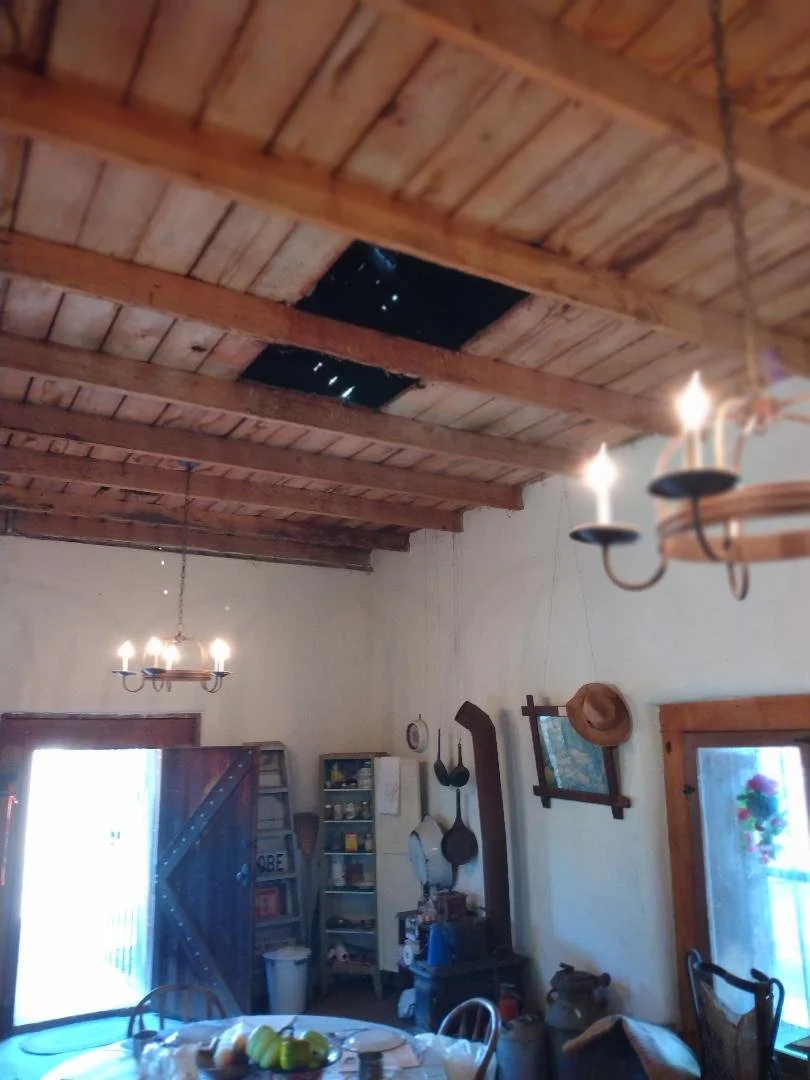Adobe structure is the oldest standing building in Rialto
By BOB SOKOLSKY
San Bernardino Sun -- January 21, 2002
Staff photos by: La Fonzo Carter (original article)
It's not the usual artifact one expects to find in a building of historic significance.
This one is short, squat, metal and rounded and it sits beneath a 19th century iron bed in a corner of the Rialto Adobe. Bette Hughbanks, president of the Rialto Historical Society, smiles at her visitor's obvious question. "Yes," she says. "That's a chamber pot. It was useful on cold nights when someone didn't want to walk to the outhouse."
But that's hardly the only item that proved useful in what is believed to be Rialto's oldest standing structure, fashioned of adobe brick and now located at the end of Millard Avenue on the edge of the city's Bud Bender Park -- formerly Lilac Park.
Built in 1853 by former seaman Michael White (also known as Michael Blanco), the adobe stands as a relatively tiny package of history. But it is capable of transporting one back to an era that was colorful and significant.
That is accomplished through numerous 19th century items.
Among them are a period oak dining room table and chairs, an oil lamp, a Republic stove, a saddle accompanied by rope and halter and a section of pipe that was used as part of the line that brought water from Lytle Creek to Rialto.
Other artifacts include oil and milk cans, a strap for a team of horses, a wash basin and pitcher, a grape press and a photograph of White, along with additional period pictures.
The adobe originally stood on the north side of Walnut Avenue, between Riverside and Sycamore avenues, and has had at least one nationally known neighbor.
"Around the mid 1800s Wyatt Earp and his family lived right down the street," Hughbanks says.
By then White had long since moved on, adding several more chapters to a life that rivaled Earp in adventure.
Most historical texts list him as a native of Kent, England, born on Feb. 10, 1801.
He was approximately 13 when we went to sea aboard the whaling ship Perseverance where he served for close to three years.
He sustained an injury, never clearly defined, while ashore in the Mexican city of La Paz and was cared for by a local couple. That seemed to endear him to the Mexican way of life and he became, for a time, a citizen of the country.
White also became a major adventurer whose voyages took him to ports around the world.
He was a privateer for a while, served aboard a Hawaiian warship and participated in numerous Mexican-American military clashes that marked the California of the late 1840s.
Hughbanks says White was believed to have built his adobe as both a shelter and a lookout point to warn of mercenaries who were looting the region.
"It was a way station. Animals were fed and sheltered here and later it was a stopping place for stagecoaches."
Histories of that period differ on White's stay in Rialto. Some say he lived about two years in his adobe, others claim nine months.
His wife and children (the couple eventually had 13 of them) were there for just a few weeks. Continued raids on the property eventually drove White away and he went on to several other activities.
And throughout his adult life he appeared to have been involved in legal battles with individuals and the American government over various land ownerships. Most historians say White died in Los Angeles in 1885, possibly destitute.
But his adobe remained a residence for several other families and Hughbanks says there was a time when it was divided into two small homes.
It underwent a major change when the local school district expressed a need for the property.
However, the Women's Club of Rialto suggested it be shifted to its present site. That project was undertaken by the Rialto Junior Chamber of Commerce and completed in December of 1961.
The Martha Stroebe book, "A History of Rialto," reveals that much of the adobe's history was uncovered during the course of that move.
It came from a large number of 1879 newspapers found in the house. Used as insulation, they remained readable although they were tacked to the inside wood with three to four inches of shavings placed over them.
They revealed the names of other adobe occupants and indicated that stagecoach activity there would probably end with the coming of the railroads. (That prediction came true in 1885.)
Meanwhile, plans were made for the restoration of the building. "It began in 1995 and it took a lot of work," Hughbanks says.
An outside plaque behind the adobe lists that project as completed between 1996 and 1997 and credits the process to the Historical Society, business firms, clubs and private individuals.
Another plaque reveals that the adobe was used by the Banning Brothers Stage Line and that early colonists from Kansas used the building as a temporary home while passing through the territory in 1887.
Additional outside features include numerous forms of cactus, succulents, oleander and other shrubbery as well as a hitching post and water trough.
The grounds and the building are under lock and key, but Hughbanks says they are readily available to schools as well as other groups and individuals who wish to journey back in time to view the adobe.
Visiting arrangements can be made by writing to the Rialto Historical Society at P.O. Box 413, Rialto, CA 92377 or by calling (909) 875-1750.
####
Click here for original article, page 1, in image form (hit Back button to return here)
Click here for original article, page 2, in image form (hit Back button to return here)



